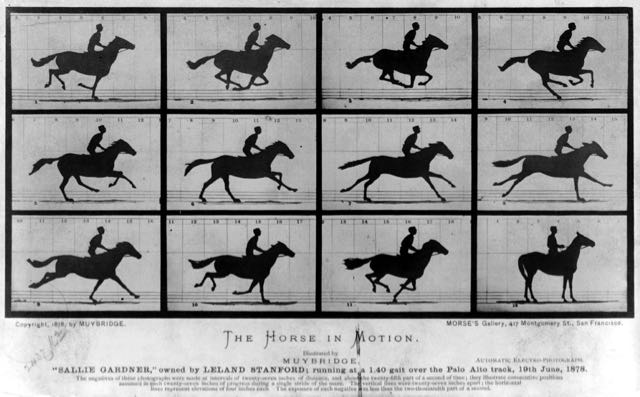A magazine where the digital world meets the real world.
On the web
- Home
- Browse by date
- Browse by topic
- Enter the maze
- Follow our blog
- Follow us on Twitter
- Resources for teachers
- Subscribe
In print
What is cs4fn?
- About us
- Contact us
- Partners
- Privacy and cookies
- Copyright and contributions
- Links to other fun sites
- Complete our questionnaire, give us feedback
Search:
Flying Horses
by Paul Curzon, Queen Mary University of London
A bet about a horse and whether it was flying or not, led to a new way to study wildlife and the first ever film showing motion as it had actually happened. It also led to an idea now used to create CGI characters - allowing us to believe things move that have never really existed.
We take it for granted that we can watch TV, movies at the cinema, drag things around on the screen of our computer or tablet, and that characters in video games move around realistically. Things on the screen or in virtual reality headsets move and we believe what we are seeing. In reality of course it is all an illusion. Nothing is moving at all. All we are seeing is a series of still images, one replaced by the next so quickly that our brains can't keep up. Our brain merges the images together and so we are fooled.
Moving images come about by playing still images faster than we can keep up, but it can also be very useful to show the images more slowly than they actually happened. That is all an action-replay is. Useful as it is for pouring over the skill of a striker in a game of football, it has proved even more useful for understanding wildlife. A desire to work out how animals move, in fact, marked the birth of the filmed moving image.
It’s actually only relatively recently, 150 years or so ago, that we have really known how animals run. It was originally all down to a bet. An argument was raging about how horses actually ran. Race horse owner, Leland Stanford, thought that a horse must, for fractions of a second, have all four feet off the ground as it galloped. Others thought this was silly. It would mean the horse was flying. The trouble was that, just like our movies today, horses feet move faster than the eye can see.
To settle the argument Stanford funded photographer Eadweard Muybridge to prove he was right. Muybridge did so, managing to take an action photograph of a horse with all four hooves off the ground. He didn't stop there though and continued to perfect a way to see exactly how horses ran. He came up with a clever way to do it. He set up lots of trip wires connected to a row of cameras. As the horse galloped past the cameras, the trip wires fired the camera shutters giving a sequence of pictures showing all the stages of the horse in motion. Clearly, there were points when all four feet were off the ground. By showing the pictures one after another - animating them - in a magic lantern you could even see the horse slowed down enough to see exactly how it galloped. This is exactly how films, cartoons and your computer desktop today fools our brain in to thinking it is seeing movement. Muybridge's animation was the first time this had been done with real images of something that had actually happened.
In modern wildlife programs, the super-slow motion that allows to see in amazing detail the motion of animals as they chase prey is essentially just building on Eadweard Muybridge's ideas. Digital cameras can take highly detailed images really quickly. That means that the wildlife films can use more individual images than are needed to fool the brain in to seeing motion. Take twice as many shots every second as actually needed, for example, and you can then play the action at half the speed and still make our brains think they are seeing the movement.
This idea of using multiple cameras to track objects was revolutionary at the time. Now it is the standard way used in the film industry to create computer generated (CGI) characters. To get the motion of a CGI character, an actor still plays the part, but surrounded by cameras. The images from the characters are synchonised and turned in to a digital three dimensional computer model that can then be superimposed on the made-up character so that the CGI's movement is as accurate and lifelike as the actor's performance.
So what was originally a creative idea giving a way to see reality as it really was is now being used to make us see things that aren't there at all.




